Business Operations Report: Accounting, HR, Leadership, and Motivation
VerifiedAdded on 2020/06/04
|7
|1703
|44
Report
AI Summary
This report examines business operations, focusing on LIDL as a case study. It covers the significance of accounting for business success, exploring financial statements and cost management. The report details various functions of the human resource department, including recruitment, training, and compensation, along with key features of employment legislation. It analyzes profit and loss accounts, interprets financial information, and assesses team roles and dynamics. The report also delves into different leadership styles and motivational theories, such as Maslow's hierarchy of needs and McClelland's need theory, to encourage workers and enhance overall business performance. The report also covers the steps involved in team development and how leadership styles can be adapted to different situations. The report concludes with a summary of the key findings and references used.
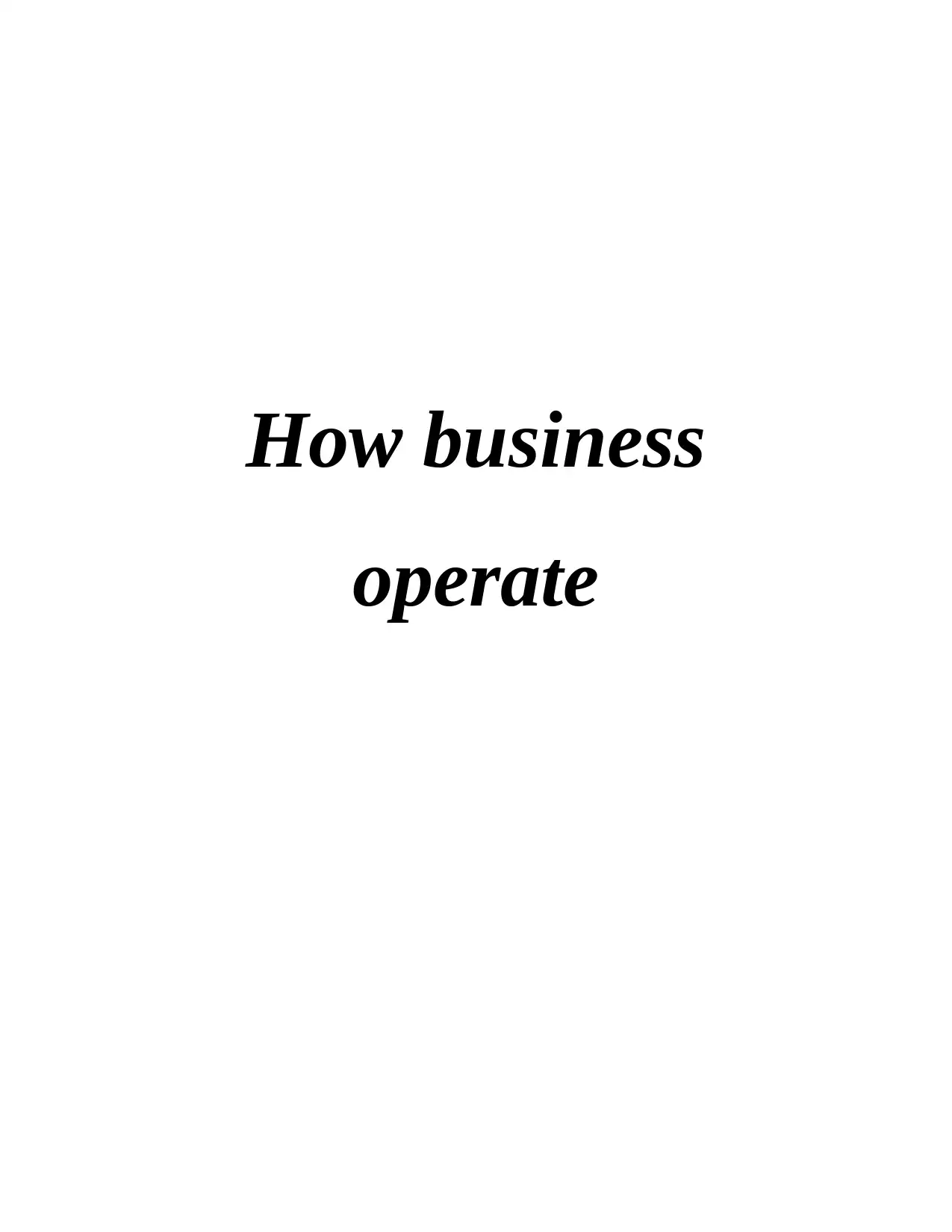
How business
operate
operate
Paraphrase This Document
Need a fresh take? Get an instant paraphrase of this document with our AI Paraphraser
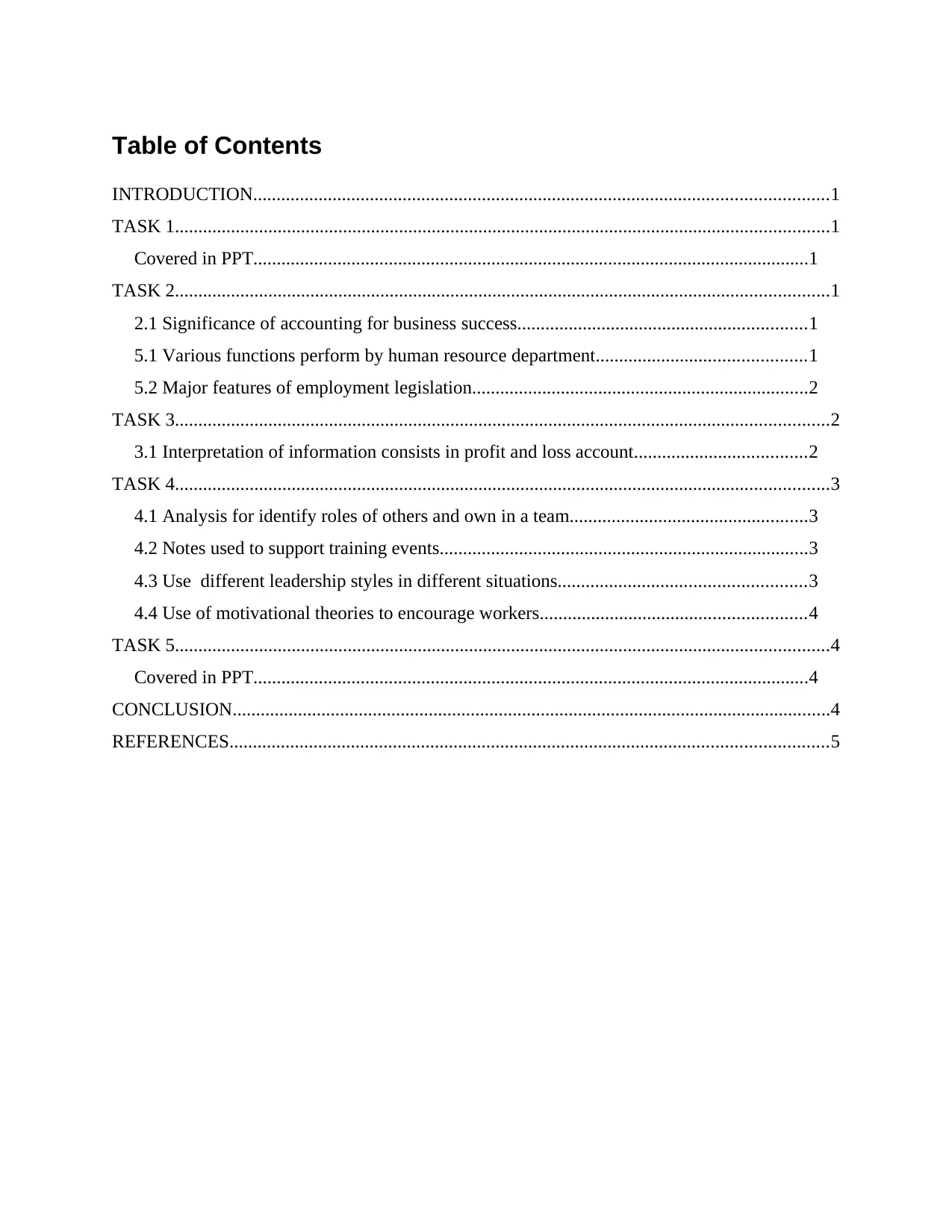
Table of Contents
INTRODUCTION...........................................................................................................................1
TASK 1............................................................................................................................................1
Covered in PPT.......................................................................................................................1
TASK 2............................................................................................................................................1
2.1 Significance of accounting for business success..............................................................1
5.1 Various functions perform by human resource department.............................................1
5.2 Major features of employment legislation........................................................................2
TASK 3............................................................................................................................................2
3.1 Interpretation of information consists in profit and loss account.....................................2
TASK 4............................................................................................................................................3
4.1 Analysis for identify roles of others and own in a team...................................................3
4.2 Notes used to support training events...............................................................................3
4.3 Use different leadership styles in different situations.....................................................3
4.4 Use of motivational theories to encourage workers.........................................................4
TASK 5............................................................................................................................................4
Covered in PPT.......................................................................................................................4
CONCLUSION................................................................................................................................4
REFERENCES................................................................................................................................5
INTRODUCTION...........................................................................................................................1
TASK 1............................................................................................................................................1
Covered in PPT.......................................................................................................................1
TASK 2............................................................................................................................................1
2.1 Significance of accounting for business success..............................................................1
5.1 Various functions perform by human resource department.............................................1
5.2 Major features of employment legislation........................................................................2
TASK 3............................................................................................................................................2
3.1 Interpretation of information consists in profit and loss account.....................................2
TASK 4............................................................................................................................................3
4.1 Analysis for identify roles of others and own in a team...................................................3
4.2 Notes used to support training events...............................................................................3
4.3 Use different leadership styles in different situations.....................................................3
4.4 Use of motivational theories to encourage workers.........................................................4
TASK 5............................................................................................................................................4
Covered in PPT.......................................................................................................................4
CONCLUSION................................................................................................................................4
REFERENCES................................................................................................................................5
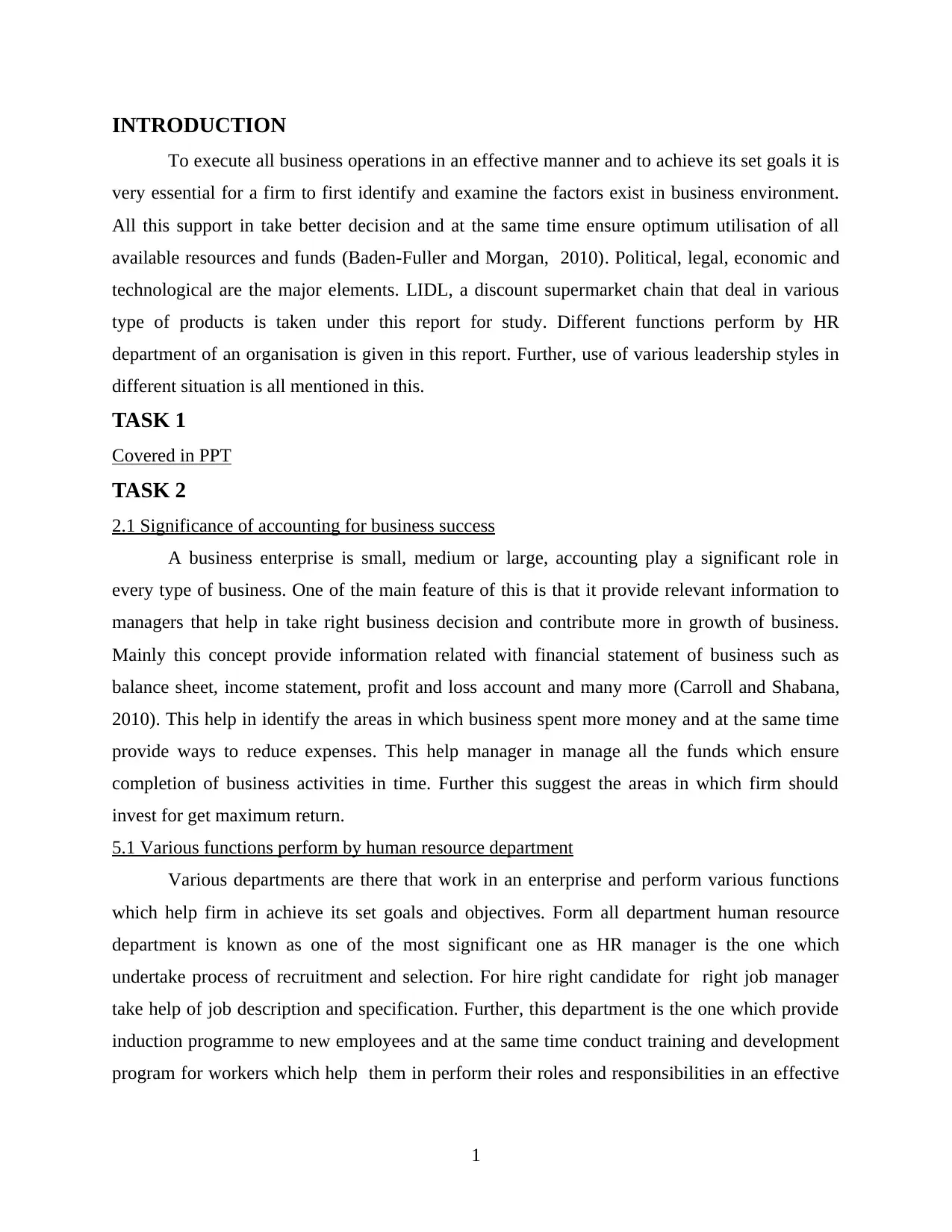
INTRODUCTION
To execute all business operations in an effective manner and to achieve its set goals it is
very essential for a firm to first identify and examine the factors exist in business environment.
All this support in take better decision and at the same time ensure optimum utilisation of all
available resources and funds (Baden-Fuller and Morgan, 2010). Political, legal, economic and
technological are the major elements. LIDL, a discount supermarket chain that deal in various
type of products is taken under this report for study. Different functions perform by HR
department of an organisation is given in this report. Further, use of various leadership styles in
different situation is all mentioned in this.
TASK 1
Covered in PPT
TASK 2
2.1 Significance of accounting for business success
A business enterprise is small, medium or large, accounting play a significant role in
every type of business. One of the main feature of this is that it provide relevant information to
managers that help in take right business decision and contribute more in growth of business.
Mainly this concept provide information related with financial statement of business such as
balance sheet, income statement, profit and loss account and many more (Carroll and Shabana,
2010). This help in identify the areas in which business spent more money and at the same time
provide ways to reduce expenses. This help manager in manage all the funds which ensure
completion of business activities in time. Further this suggest the areas in which firm should
invest for get maximum return.
5.1 Various functions perform by human resource department
Various departments are there that work in an enterprise and perform various functions
which help firm in achieve its set goals and objectives. Form all department human resource
department is known as one of the most significant one as HR manager is the one which
undertake process of recruitment and selection. For hire right candidate for right job manager
take help of job description and specification. Further, this department is the one which provide
induction programme to new employees and at the same time conduct training and development
program for workers which help them in perform their roles and responsibilities in an effective
1
To execute all business operations in an effective manner and to achieve its set goals it is
very essential for a firm to first identify and examine the factors exist in business environment.
All this support in take better decision and at the same time ensure optimum utilisation of all
available resources and funds (Baden-Fuller and Morgan, 2010). Political, legal, economic and
technological are the major elements. LIDL, a discount supermarket chain that deal in various
type of products is taken under this report for study. Different functions perform by HR
department of an organisation is given in this report. Further, use of various leadership styles in
different situation is all mentioned in this.
TASK 1
Covered in PPT
TASK 2
2.1 Significance of accounting for business success
A business enterprise is small, medium or large, accounting play a significant role in
every type of business. One of the main feature of this is that it provide relevant information to
managers that help in take right business decision and contribute more in growth of business.
Mainly this concept provide information related with financial statement of business such as
balance sheet, income statement, profit and loss account and many more (Carroll and Shabana,
2010). This help in identify the areas in which business spent more money and at the same time
provide ways to reduce expenses. This help manager in manage all the funds which ensure
completion of business activities in time. Further this suggest the areas in which firm should
invest for get maximum return.
5.1 Various functions perform by human resource department
Various departments are there that work in an enterprise and perform various functions
which help firm in achieve its set goals and objectives. Form all department human resource
department is known as one of the most significant one as HR manager is the one which
undertake process of recruitment and selection. For hire right candidate for right job manager
take help of job description and specification. Further, this department is the one which provide
induction programme to new employees and at the same time conduct training and development
program for workers which help them in perform their roles and responsibilities in an effective
1
⊘ This is a preview!⊘
Do you want full access?
Subscribe today to unlock all pages.

Trusted by 1+ million students worldwide
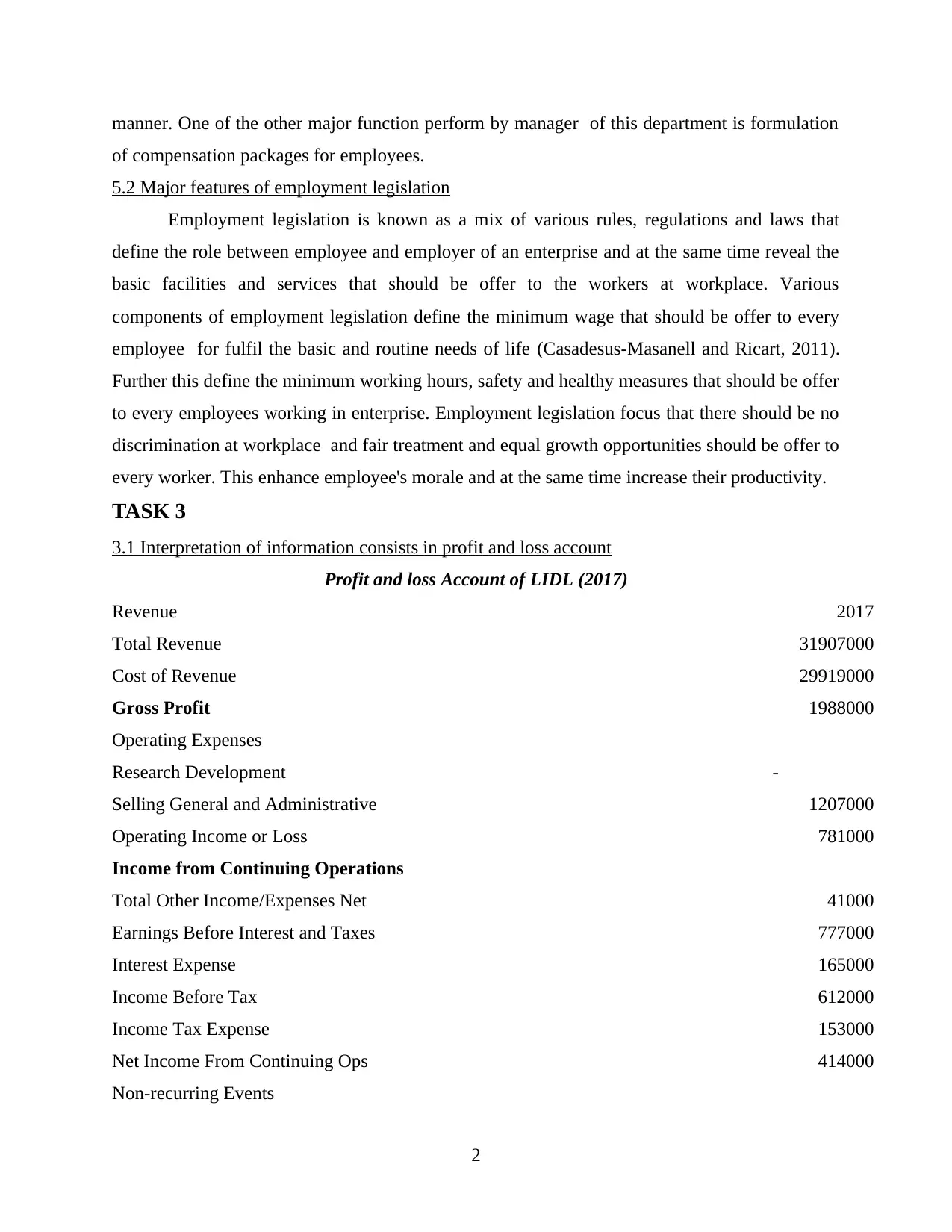
manner. One of the other major function perform by manager of this department is formulation
of compensation packages for employees.
5.2 Major features of employment legislation
Employment legislation is known as a mix of various rules, regulations and laws that
define the role between employee and employer of an enterprise and at the same time reveal the
basic facilities and services that should be offer to the workers at workplace. Various
components of employment legislation define the minimum wage that should be offer to every
employee for fulfil the basic and routine needs of life (Casadesus-Masanell and Ricart, 2011).
Further this define the minimum working hours, safety and healthy measures that should be offer
to every employees working in enterprise. Employment legislation focus that there should be no
discrimination at workplace and fair treatment and equal growth opportunities should be offer to
every worker. This enhance employee's morale and at the same time increase their productivity.
TASK 3
3.1 Interpretation of information consists in profit and loss account
Profit and loss Account of LIDL (2017)
Revenue 2017
Total Revenue 31907000
Cost of Revenue 29919000
Gross Profit 1988000
Operating Expenses
Research Development -
Selling General and Administrative 1207000
Operating Income or Loss 781000
Income from Continuing Operations
Total Other Income/Expenses Net 41000
Earnings Before Interest and Taxes 777000
Interest Expense 165000
Income Before Tax 612000
Income Tax Expense 153000
Net Income From Continuing Ops 414000
Non-recurring Events
2
of compensation packages for employees.
5.2 Major features of employment legislation
Employment legislation is known as a mix of various rules, regulations and laws that
define the role between employee and employer of an enterprise and at the same time reveal the
basic facilities and services that should be offer to the workers at workplace. Various
components of employment legislation define the minimum wage that should be offer to every
employee for fulfil the basic and routine needs of life (Casadesus-Masanell and Ricart, 2011).
Further this define the minimum working hours, safety and healthy measures that should be offer
to every employees working in enterprise. Employment legislation focus that there should be no
discrimination at workplace and fair treatment and equal growth opportunities should be offer to
every worker. This enhance employee's morale and at the same time increase their productivity.
TASK 3
3.1 Interpretation of information consists in profit and loss account
Profit and loss Account of LIDL (2017)
Revenue 2017
Total Revenue 31907000
Cost of Revenue 29919000
Gross Profit 1988000
Operating Expenses
Research Development -
Selling General and Administrative 1207000
Operating Income or Loss 781000
Income from Continuing Operations
Total Other Income/Expenses Net 41000
Earnings Before Interest and Taxes 777000
Interest Expense 165000
Income Before Tax 612000
Income Tax Expense 153000
Net Income From Continuing Ops 414000
Non-recurring Events
2
Paraphrase This Document
Need a fresh take? Get an instant paraphrase of this document with our AI Paraphraser
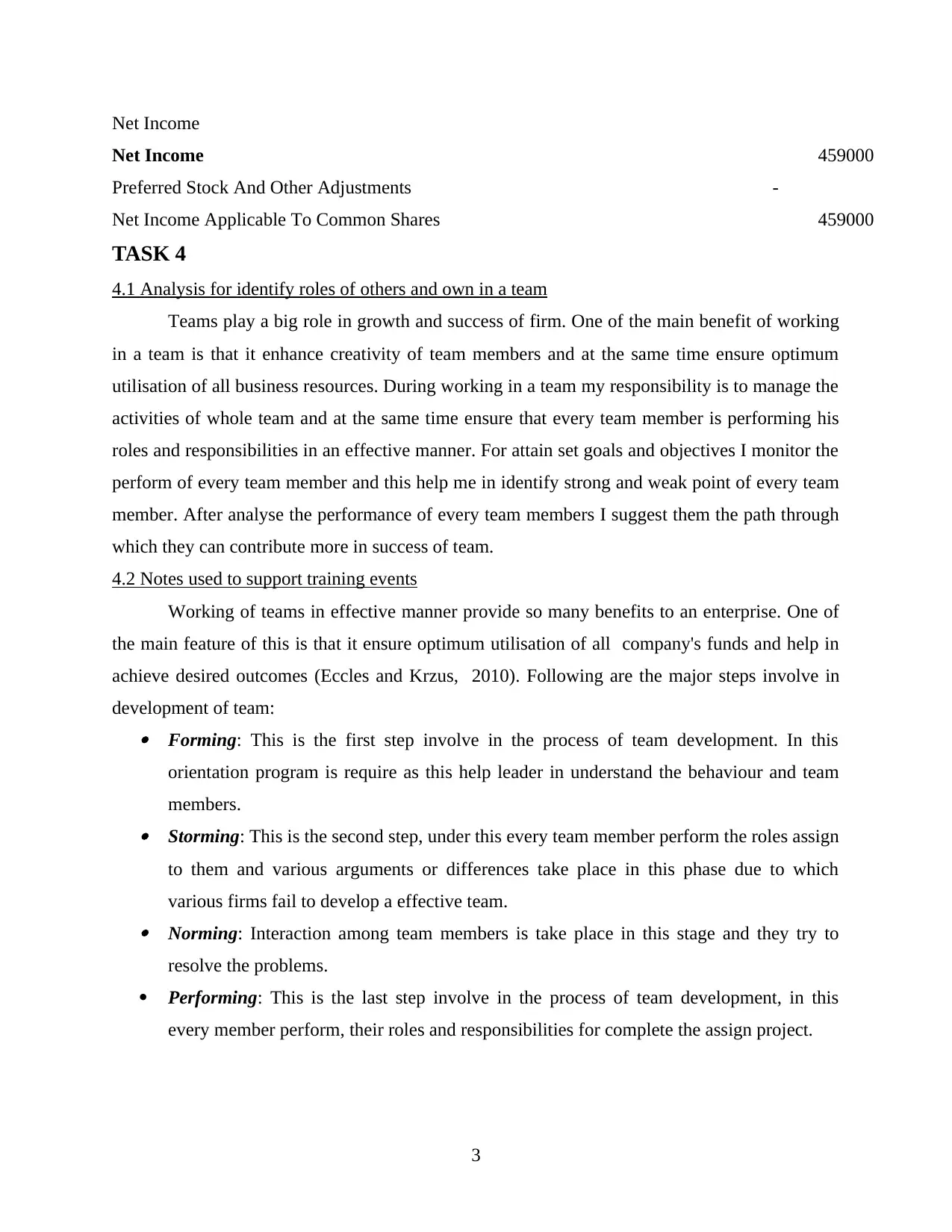
Net Income
Net Income 459000
Preferred Stock And Other Adjustments -
Net Income Applicable To Common Shares 459000
TASK 4
4.1 Analysis for identify roles of others and own in a team
Teams play a big role in growth and success of firm. One of the main benefit of working
in a team is that it enhance creativity of team members and at the same time ensure optimum
utilisation of all business resources. During working in a team my responsibility is to manage the
activities of whole team and at the same time ensure that every team member is performing his
roles and responsibilities in an effective manner. For attain set goals and objectives I monitor the
perform of every team member and this help me in identify strong and weak point of every team
member. After analyse the performance of every team members I suggest them the path through
which they can contribute more in success of team.
4.2 Notes used to support training events
Working of teams in effective manner provide so many benefits to an enterprise. One of
the main feature of this is that it ensure optimum utilisation of all company's funds and help in
achieve desired outcomes (Eccles and Krzus, 2010). Following are the major steps involve in
development of team: Forming: This is the first step involve in the process of team development. In this
orientation program is require as this help leader in understand the behaviour and team
members. Storming: This is the second step, under this every team member perform the roles assign
to them and various arguments or differences take place in this phase due to which
various firms fail to develop a effective team. Norming: Interaction among team members is take place in this stage and they try to
resolve the problems.
Performing: This is the last step involve in the process of team development, in this
every member perform, their roles and responsibilities for complete the assign project.
3
Net Income 459000
Preferred Stock And Other Adjustments -
Net Income Applicable To Common Shares 459000
TASK 4
4.1 Analysis for identify roles of others and own in a team
Teams play a big role in growth and success of firm. One of the main benefit of working
in a team is that it enhance creativity of team members and at the same time ensure optimum
utilisation of all business resources. During working in a team my responsibility is to manage the
activities of whole team and at the same time ensure that every team member is performing his
roles and responsibilities in an effective manner. For attain set goals and objectives I monitor the
perform of every team member and this help me in identify strong and weak point of every team
member. After analyse the performance of every team members I suggest them the path through
which they can contribute more in success of team.
4.2 Notes used to support training events
Working of teams in effective manner provide so many benefits to an enterprise. One of
the main feature of this is that it ensure optimum utilisation of all company's funds and help in
achieve desired outcomes (Eccles and Krzus, 2010). Following are the major steps involve in
development of team: Forming: This is the first step involve in the process of team development. In this
orientation program is require as this help leader in understand the behaviour and team
members. Storming: This is the second step, under this every team member perform the roles assign
to them and various arguments or differences take place in this phase due to which
various firms fail to develop a effective team. Norming: Interaction among team members is take place in this stage and they try to
resolve the problems.
Performing: This is the last step involve in the process of team development, in this
every member perform, their roles and responsibilities for complete the assign project.
3
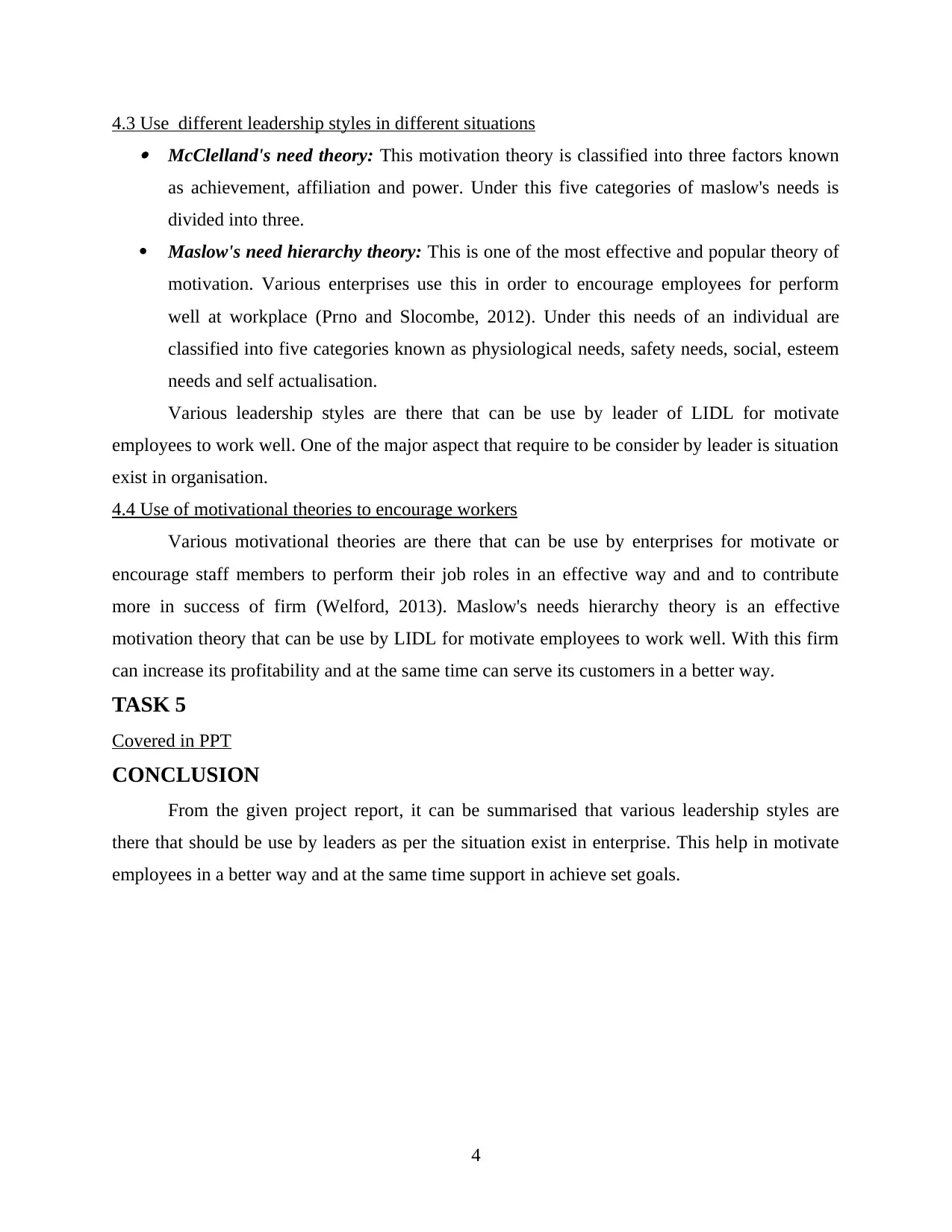
4.3 Use different leadership styles in different situations McClelland's need theory: This motivation theory is classified into three factors known
as achievement, affiliation and power. Under this five categories of maslow's needs is
divided into three.
Maslow's need hierarchy theory: This is one of the most effective and popular theory of
motivation. Various enterprises use this in order to encourage employees for perform
well at workplace (Prno and Slocombe, 2012). Under this needs of an individual are
classified into five categories known as physiological needs, safety needs, social, esteem
needs and self actualisation.
Various leadership styles are there that can be use by leader of LIDL for motivate
employees to work well. One of the major aspect that require to be consider by leader is situation
exist in organisation.
4.4 Use of motivational theories to encourage workers
Various motivational theories are there that can be use by enterprises for motivate or
encourage staff members to perform their job roles in an effective way and and to contribute
more in success of firm (Welford, 2013). Maslow's needs hierarchy theory is an effective
motivation theory that can be use by LIDL for motivate employees to work well. With this firm
can increase its profitability and at the same time can serve its customers in a better way.
TASK 5
Covered in PPT
CONCLUSION
From the given project report, it can be summarised that various leadership styles are
there that should be use by leaders as per the situation exist in enterprise. This help in motivate
employees in a better way and at the same time support in achieve set goals.
4
as achievement, affiliation and power. Under this five categories of maslow's needs is
divided into three.
Maslow's need hierarchy theory: This is one of the most effective and popular theory of
motivation. Various enterprises use this in order to encourage employees for perform
well at workplace (Prno and Slocombe, 2012). Under this needs of an individual are
classified into five categories known as physiological needs, safety needs, social, esteem
needs and self actualisation.
Various leadership styles are there that can be use by leader of LIDL for motivate
employees to work well. One of the major aspect that require to be consider by leader is situation
exist in organisation.
4.4 Use of motivational theories to encourage workers
Various motivational theories are there that can be use by enterprises for motivate or
encourage staff members to perform their job roles in an effective way and and to contribute
more in success of firm (Welford, 2013). Maslow's needs hierarchy theory is an effective
motivation theory that can be use by LIDL for motivate employees to work well. With this firm
can increase its profitability and at the same time can serve its customers in a better way.
TASK 5
Covered in PPT
CONCLUSION
From the given project report, it can be summarised that various leadership styles are
there that should be use by leaders as per the situation exist in enterprise. This help in motivate
employees in a better way and at the same time support in achieve set goals.
4
⊘ This is a preview!⊘
Do you want full access?
Subscribe today to unlock all pages.

Trusted by 1+ million students worldwide
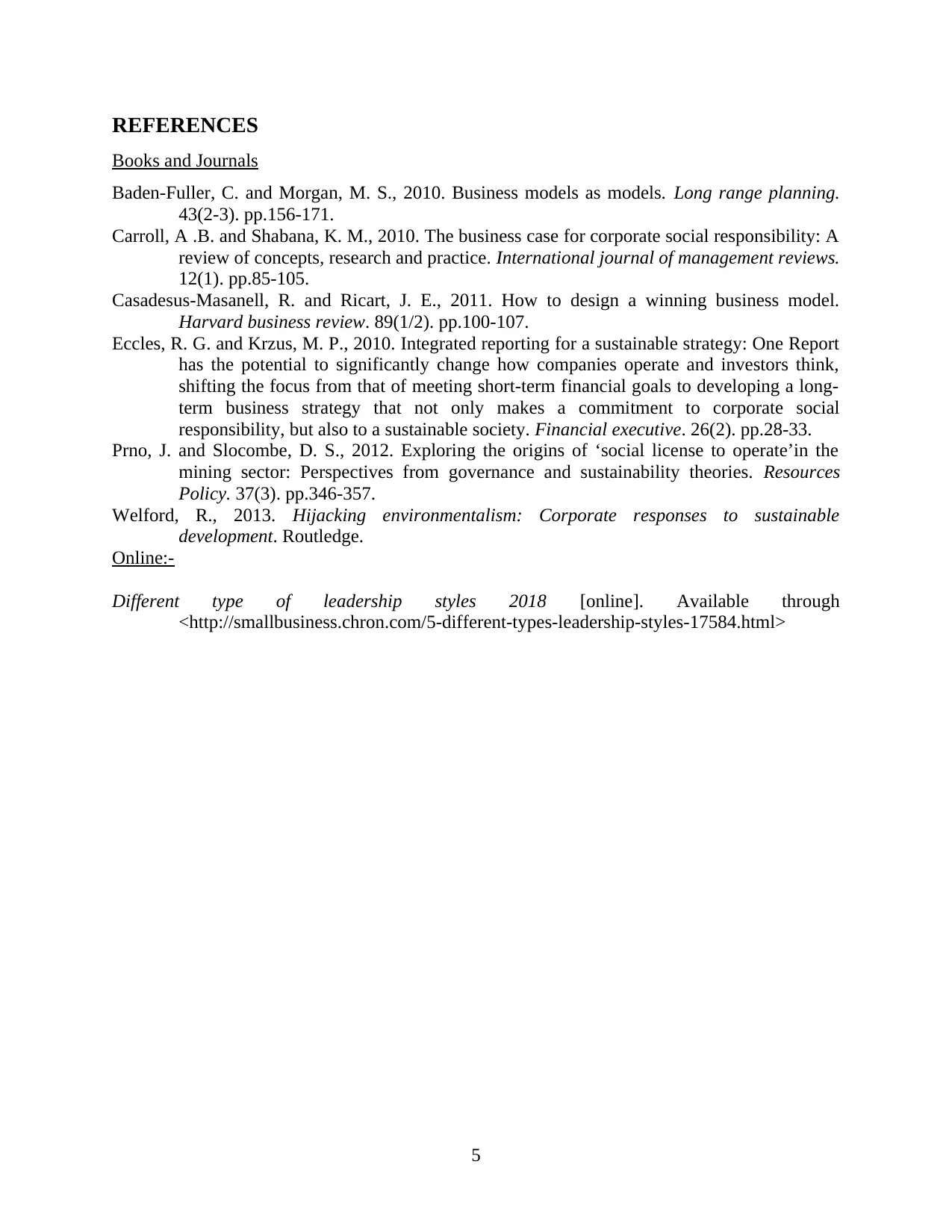
REFERENCES
Books and Journals
Baden-Fuller, C. and Morgan, M. S., 2010. Business models as models. Long range planning.
43(2-3). pp.156-171.
Carroll, A .B. and Shabana, K. M., 2010. The business case for corporate social responsibility: A
review of concepts, research and practice. International journal of management reviews.
12(1). pp.85-105.
Casadesus-Masanell, R. and Ricart, J. E., 2011. How to design a winning business model.
Harvard business review. 89(1/2). pp.100-107.
Eccles, R. G. and Krzus, M. P., 2010. Integrated reporting for a sustainable strategy: One Report
has the potential to significantly change how companies operate and investors think,
shifting the focus from that of meeting short-term financial goals to developing a long-
term business strategy that not only makes a commitment to corporate social
responsibility, but also to a sustainable society. Financial executive. 26(2). pp.28-33.
Prno, J. and Slocombe, D. S., 2012. Exploring the origins of ‘social license to operate’in the
mining sector: Perspectives from governance and sustainability theories. Resources
Policy. 37(3). pp.346-357.
Welford, R., 2013. Hijacking environmentalism: Corporate responses to sustainable
development. Routledge.
Online:-
Different type of leadership styles 2018 [online]. Available through
<http://smallbusiness.chron.com/5-different-types-leadership-styles-17584.html>
5
Books and Journals
Baden-Fuller, C. and Morgan, M. S., 2010. Business models as models. Long range planning.
43(2-3). pp.156-171.
Carroll, A .B. and Shabana, K. M., 2010. The business case for corporate social responsibility: A
review of concepts, research and practice. International journal of management reviews.
12(1). pp.85-105.
Casadesus-Masanell, R. and Ricart, J. E., 2011. How to design a winning business model.
Harvard business review. 89(1/2). pp.100-107.
Eccles, R. G. and Krzus, M. P., 2010. Integrated reporting for a sustainable strategy: One Report
has the potential to significantly change how companies operate and investors think,
shifting the focus from that of meeting short-term financial goals to developing a long-
term business strategy that not only makes a commitment to corporate social
responsibility, but also to a sustainable society. Financial executive. 26(2). pp.28-33.
Prno, J. and Slocombe, D. S., 2012. Exploring the origins of ‘social license to operate’in the
mining sector: Perspectives from governance and sustainability theories. Resources
Policy. 37(3). pp.346-357.
Welford, R., 2013. Hijacking environmentalism: Corporate responses to sustainable
development. Routledge.
Online:-
Different type of leadership styles 2018 [online]. Available through
<http://smallbusiness.chron.com/5-different-types-leadership-styles-17584.html>
5
1 out of 7
Related Documents
Your All-in-One AI-Powered Toolkit for Academic Success.
+13062052269
info@desklib.com
Available 24*7 on WhatsApp / Email
![[object Object]](/_next/static/media/star-bottom.7253800d.svg)
Unlock your academic potential
Copyright © 2020–2025 A2Z Services. All Rights Reserved. Developed and managed by ZUCOL.





